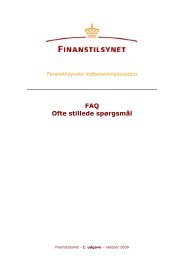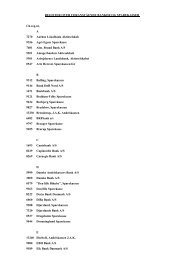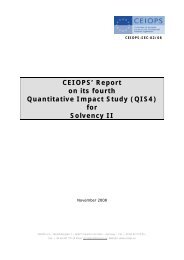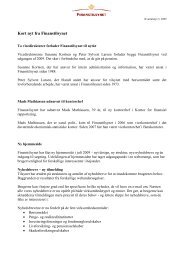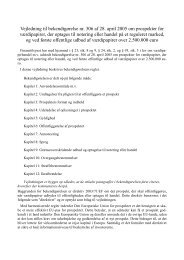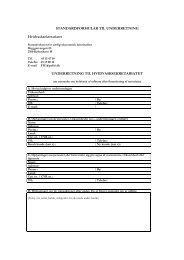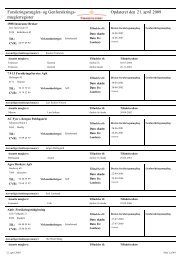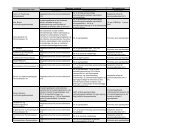7th extract from EECS's database of enforcement decisions - Esma
7th extract from EECS's database of enforcement decisions - Esma
7th extract from EECS's database of enforcement decisions - Esma
You also want an ePaper? Increase the reach of your titles
YUMPU automatically turns print PDFs into web optimized ePapers that Google loves.
COMMITTEE OF EUROPEAN SECURITIES REGULATORSDate: 16 December 2009Ref.: CESR/09-1134<strong>7th</strong> Extract <strong>from</strong> EECS’sDatabase <strong>of</strong> EnforcementCESR, 11-13 avenue de Friedland, 75008 Paris, France - Tel +33 (0)1 58 36 43 21, web site: www.cesr.eu
Table <strong>of</strong> contentsINTRODUCTION ........................................................................................................................................... 3DECISION REF.EECS/1209-01: RESTRUCTURING OF FINANCIAL OBLIGATIONS ......................... 4DECISION REF.EECS/1209-02: CLASSIFICATION OF A LOAN ............................................................. 5DECISION REF.EECS/1209-03: PRESENTATION OF FINANCIAL INSTRUMENTS ............................ 5DECISION REF.EECS/1209-04: CLASSIFICATION OF CASH AND CASH EQUIVALENTS ................ 6DECISION REF.EECS/1209-05: REVENUE RECOGNITION .................................................................... 7DECISION REF.EECS/1209-06: CUSTOMER LOYALTY PROGRAMME............................................... 8DECISION REF.EECS/1209-07: SEGMENTAL REPORTING ................................................................... 9DECISION REF.EECS/1209-08: PROVISIONS AND CONTINGENT LIABILITIES ............................. 10DECISION REF.EECS/1209-09: CORRECTION OF AN ERROR ............................................................ 11DECISION REF.EECS/1209-10: HALF-YEARLY CONSOLIDATED CASH FLOW STATEMENT ..... 12DECISION REF.EECS/1209-11: RELATED PARTY DISCLOSURES ..................................................... 12DECISION REF.EECS/1209-12: PROVISIONAL PURCHASE PRICE ALLOCATION OF A BUSINESSCOMBINATION ........................................................................................................................................... 14DECISION REF.EECS/1209-13: PURCHASE PRICE ALLOCATION OF A BUSINESS ACQUISITION14DECISION REF.EECS/1209-14: BUSINESS COMBINATION UNDER COMMON CONTROL ........... 16DECISION REF.EECS/1209-15: IDENTIFICATION OF THE ACQUIRER IN A BUSINESSCOMBINATION ........................................................................................................................................... 17DECISION REF.EECS/1209-16: IDENTIFYING THE ACQUIRER IN A BUSINESS COMBINATION 19DECISION REF.EECS/1209-17: COLLECTIVE ASSESSMENT FOR IMPAIRMENT OF LOANS ...... 212
IntroductionEU National Enforcers <strong>of</strong> financial information monitor and review financial statements andconsider whether they comply with IFRS and other applicable reporting requirements, includingrelevant national law.Operating under the operational CESR group charged with accounting issues, CESR-Fin, EECS is aforum in which all EU National Enforcers <strong>of</strong> financial information, whether CESR members or not,meet to exchange views and discuss experiences <strong>of</strong> <strong>enforcement</strong> <strong>of</strong> IFRS. A key function <strong>of</strong> EECS isthe analysis and discussion <strong>of</strong> <strong>decisions</strong> taken by independent EU National Enforcers in respect <strong>of</strong>financial statements published by issuers with securities traded on a regulated market and whoprepare their financial statements in accordance with IFRS.EECS is not a decision-making forum. It neither approves nor rejects <strong>decisions</strong> taken by EUNational Enforcers who apply their judgement, knowledge and experience to the particularcircumstances <strong>of</strong> the cases that they consider. Relevant factors may include other areas <strong>of</strong> nationallaw beyond the accounting requirements. Interested parties should therefore consider carefully theindividual circumstances when reading the cases. As IFRS are principles based, there can be no oneparticular way <strong>of</strong> dealing with numerous situations which may seem similar but in substance aredifferent. Consistent application <strong>of</strong> IFRS means consistent with the principles and treatmentspermitted by the standards.Decisions taken by Enforcers do not provide generally applicable interpretations <strong>of</strong> IFRS, whichremains the role <strong>of</strong> the International Financial Reporting Interpretations Committee (IFRIC).As proposed in CESR Standard No 2 on Financial Information, „Co-Ordination <strong>of</strong> EnforcementActivities‟, CESR has developed a confidential <strong>database</strong> <strong>of</strong> <strong>enforcement</strong> <strong>decisions</strong> taken by individualEECS members as a source <strong>of</strong> information to foster appropriate application <strong>of</strong> IFRS. In response topublic comment to the Standard, CESR committed to publish <strong>extract</strong>s <strong>of</strong> the <strong>database</strong> to provideissuers and users <strong>of</strong> financial statements with similar assistance.Publication <strong>of</strong> <strong>enforcement</strong> <strong>decisions</strong> will inform market participants about which accountingtreatments EU National Enforcers may consider as complying with IFRS; that is, whether thetreatments are considered as being within the accepted range <strong>of</strong> those permitted by the standards orIFRIC interpretations. Such publication, together with the rationale behind these <strong>decisions</strong>, willcontribute to a consistent application <strong>of</strong> IFRS in the European Union.Decisions that deal with simple or obvious accounting matters, or oversight <strong>of</strong> IFRS requirements,will not normally be published, even if they were material breaches leading to sanctions. Theselection criteria are based on the above stated objectives, and accordingly, only <strong>decisions</strong> providingmarket participants with useful guidance will be published.On this basis, all cases submitted to the <strong>enforcement</strong> <strong>database</strong> are considered as appropriate forpublication, unless:- Similar <strong>decisions</strong> have already been published by CESR, and publication <strong>of</strong> a new one wouldnot add any substantial value to the fostering <strong>of</strong> consistent application;- The decision deals with a simple accounting issue that, even having been considered amaterial infringement, does not in itself have any accounting merit;- There is no consensus in the EECS to support the submitted decision.- A particular EU National Enforcer, on a grounded and justified basis, believes that thedecision should not be published;CESR will continue publishing further <strong>extract</strong>s <strong>from</strong> the <strong>database</strong> on a regular basis.3
Decision ref.EECS/1209-01: Restructuring <strong>of</strong> financial obligationsFinancial year end: 30 September 2008 / Annual Financial StatementsCategory <strong>of</strong> issue: Restructuring <strong>of</strong> financial obligationsStandard involved: IAS 39Date <strong>of</strong> the decision: 2 March 2009Description <strong>of</strong> the issuer’s accounting treatmentIn February 2005, the issuer implemented a comprehensive restructuring <strong>of</strong> its financial obligations.The restructuring included amending the issuer‟s principal financing agreements, specifically, theconditions <strong>of</strong> several long-terms borrowings. The effect <strong>of</strong> the restructuring was to provide new cashresources to the Group, to reduce or defer cash payment obligations and to provide flexibility forinvestment and development.On the borrowings, the restructuring mainly consisted <strong>of</strong> the deferral <strong>of</strong> principal repayments (by 3or 5 years) and an increase in the effective interest rates on certain parts <strong>of</strong> the issuer‟s debt (euribor+3% instead <strong>of</strong> euribor +0,84% as it was before the restructuring). At the date <strong>of</strong> the negotiation (28February 2005), the renegotiated debts amounted to € 482 million which constituted 25% <strong>of</strong> the totallong-term financial liabilities.These changes were considered by the issuer to be “substantial modifications <strong>of</strong> the terms <strong>of</strong> existingfinancial liabilities” and therefore, were accounted for as an extinguishment <strong>of</strong> the original debt andthe recognition <strong>of</strong> new debt in accordance with IAS 39, paragraph 40.The issuer recognised in pr<strong>of</strong>it and loss the difference between the carrying amount <strong>of</strong> the originaldebt that was extinguished and the fair value <strong>of</strong> the new debt. This resulted in a pr<strong>of</strong>it <strong>of</strong> 69 millioneuro. The issuer also charged pr<strong>of</strong>it and loss with 9.7 million euro in issue and renegotiation costs.The issuer recognised the new debt at its fair value on the balance sheet.After initial recognition, the issuer subsequently measured the new debt at amortised cost using theeffective interest method.The <strong>enforcement</strong> decisionThe enforcer accepted that the accounting treatment adopted complied with IAS 39.Rationale for the <strong>enforcement</strong> decisionIAS 39, paragraph 40 provides that an exchange between an existing borrower and lender <strong>of</strong> debtinstruments with substantially different terms should be accounted for as an extinguishment <strong>of</strong> theoriginal debt and the recognition <strong>of</strong> a new financial liability. AG 62 states that, for this purpose,terms are substantially different if the discounted present value <strong>of</strong> the cash flows under the newterms, including any fees paid net <strong>of</strong> any fees received and discounted using the original effectiveinterest rate, is at least 10 per cent different <strong>from</strong> the discounted present value <strong>of</strong> the remainingcash flows <strong>of</strong> the original financial liability.The enforcer satisfied itself that the discounted present value <strong>of</strong> the cash flows under the new terms,using the initial effective interest rate, were indeed more than 10% different <strong>from</strong> the discountedpresent value <strong>of</strong> the remaining cash flows <strong>of</strong> the original debt. On that basis, the enforcer concludedthat the new terms <strong>of</strong> the debt were substantially different <strong>from</strong> the initial terms and thatparagraph 40 <strong>of</strong> IAS 39 was applicable.AG 62 also states that where an exchange <strong>of</strong> debt instruments is accounted for as anextinguishment, any costs or fees incurred are recognised as part <strong>of</strong> the gain. The enforcer thereforeagreed that the 9.7 million euro costs and fees incurred in the restructuring should be recognised aspart <strong>of</strong> the gain.4
Decision ref.EECS/1209-02: Classification <strong>of</strong> a loanFinancial year end: 31 December 2008 / Interim Financial StatementsCategory <strong>of</strong> issue: Classification <strong>of</strong> loanStandard involved: IAS 1Date <strong>of</strong> the decision: 23 April 2009Description <strong>of</strong> the issuer’s accounting treatmentIn November 2008, the issuer defaulted on an interest payment on an issued bond loan <strong>of</strong> USD 100million. The loan agreement stipulates that such default can lead to an obligation to repay thewhole <strong>of</strong> the loan immediately, including incurred interest and expenses. The bondholders, however,issued a waiver postponing the interest payment until 19 December 2008. On 17 December theissuer summoned a meeting <strong>of</strong> the bondholders and requested a further waiver <strong>of</strong> the interestpayment to February 5 2009. The extension was granted by the bondholders at a further meetingheld on January 6.The issuer classified the loan as long term debt in its balance sheet at 31 December (issued February26) on the basis that the loan was not in default at the balance sheet date as the bondholders hadissued waivers and had not sought redemption.The <strong>enforcement</strong> decisionThe enforcer found that the loan should have been classified as short term debt as the issuer did nothave an unconditional right to defer payment for at least twelve months after the balance sheet dateas required by IAS 1, paragraphs 65 and 66 in order to be classified as short term debt.RationaleAccording to IAS 1 paragraph 60 d a liability should be classified as current if it is due to be settledwithin twelve months after the balance sheet date. Paragraph 65 clarifies that, if an issuer breachesan undertaking under a long-term loan agreement on or before the balance sheet date, such that thedebt becomes payable on demand, the loan is classified as current even if the lender agrees, after thebalance sheet date, not to demand payment as a consequence <strong>of</strong> the breach. It follows <strong>from</strong> IAS 1paragraph 66 that a liability should also be classified as current if a waiver is issued before thebalance sheet date, but does not give the issuer a period <strong>of</strong> grace ending at least twelve months afterthe balance sheet date.In the enforcer‟s opinion, the default on the interest payment in November represented a defaultthat could have led to a claim <strong>from</strong> the bond holders to repay the totality <strong>of</strong> the loan immediately,inclusive <strong>of</strong> incurred interest and expenses. As the waiver was issued after the balance sheet date,and only postponed payment for a short period, the issuer did not have an unconditional right todefer the payment for at least twelve months after the balance sheet date as required by thestandard in order to be classified as long term debt.* * *Decision ref.EECS/1209-03: Presentation <strong>of</strong> financial instrumentsFinancial year end: 31 December 2007 / Annual Financial StatementsCategory <strong>of</strong> issue: Presentation <strong>of</strong> financial instrumentsStandard involved: IFRS 7Date <strong>of</strong> the decision: 16 October 2008Description <strong>of</strong> the issuer’s accounting treatment5
The issuer is a financial institution with significant US sub- prime related investments classified asavailable for sale investments.The issuer‟s financial statements disclosed how much <strong>of</strong> the fair value <strong>of</strong> the available for saleinvestments was determined, in whole or in part, directly by reference to published price quotationsin an active market or was estimated using a valuation technique supported by observable marketdata or was estimated using a valuation technique supported by non observable market data asrequired by paragraph 27 <strong>of</strong> IFRS 7.In a subsequent analysts‟ presentation, the issuer presented this same information in respect <strong>of</strong> itsUS sub-prime related investments and which was not disclosed in the accounts. The issuer did notconsider there to be any requirement to disclose this information on a product basis in the accountsbut provided it voluntarily to analysts believing there to be an interest in information that wentbeyond that required by the specific disclosure requirements <strong>of</strong> IFRS 7.The <strong>enforcement</strong> decisionThe enforcer found that the information about the US sub-prime investments disclosed to analystsshould also have been presented in the accounts in accordance with paragraph 27(b)(c) <strong>of</strong> IFRS 7.Rationale for the <strong>enforcement</strong> decisionThe objective <strong>of</strong> IFRS 7 is to require disclosures that enable users to evaluate the significance <strong>of</strong>financial instruments for the entity‟s financial position and performance and the nature and extent<strong>of</strong> risks arising <strong>from</strong> financial instruments to which the entity is exposed.Although the information required by paragraphs 6 and 27 <strong>of</strong> IFRS 7 do not specifically require it tobe provided on a product basis, it was concluded that, in this case, the additional detail wasnecessary in order to enable users to evaluate the significance <strong>of</strong> US sub-prime investments to theissuer‟s position and performance and to meet the objective <strong>of</strong> the standard.* * *Decision ref.EECS/1209-04: Classification <strong>of</strong> cash and cash equivalentsFinancial year end: 31 March 2008 / Annual Financial StatementsCategory <strong>of</strong> issue: Classification <strong>of</strong> cash and cash equivalentsStandard involved: IAS 7Date <strong>of</strong> the decision: 31 March 2008Description <strong>of</strong> the issuer’s accounting treatmentThe issuer, a private equity and venture capital provider, presented in its 2008 accounts an amount<strong>of</strong> 538 million euro as cash and cash equivalents on the face <strong>of</strong> its balance sheet as required by IAS 1,paragraph 68. The accounting policies stated that, in accordance with paragraph 108 <strong>of</strong> thestandard, cash and cash equivalents comprised cash on hand, cash with banks and short-termdeposits, explaining that cash and cash equivalents were carried at nominal value but that thecarrying amounts approximated their fair value, given their short-term nature.The notes to the accounts on the other hand, disclosed an analysis <strong>of</strong> the 538 million MU asmarketable securities and other instruments <strong>of</strong> 456 million euro, short-term bank deposits <strong>of</strong> 18million MU and cash and other cash equivalents <strong>of</strong> 64 million MU. The note explained that themarketable securities were invested in “immediately realizable instruments like bonds, CDOs andinvestment funds".6
The <strong>enforcement</strong> decisionThe enforcer concluded that, contrary to its stated accounting policy, the amounts included in cashand cash equivalents on the issuer‟s balance sheet comprised amounts, the nature <strong>of</strong> which did notsatisfy the definition <strong>of</strong> cash and cash equivalents as set out in IAS 7.Rationale for the <strong>enforcement</strong> decisionIAS 7, paragraph 6, defines cash as cash on hand and demand deposits and cash equivalents asshort-term, highly liquid investments that are readily convertible to known amounts <strong>of</strong> cash andwhich are subject to an insignificant risk <strong>of</strong> changes in value.The enforcer noted that the 538 million euro reported on the face <strong>of</strong> the balance sheet comprisedcertain investments that do not meet this definition. Contrary to the stated accounting policies, thefinancial statements showed that significant value reductions were booked through pr<strong>of</strong>it and loss inrespect <strong>of</strong> certain investments included in cash and cash equivalents, for example, the CDOs. It alsoappeared to the enforcer that some <strong>of</strong> the investments were neither short-term nor liquid.* * *Decision ref.EECS/1209-05: Revenue recognitionFinancial year end: 31 December 2007 / Annual Financial StatementsCategory <strong>of</strong> issue: Revenue recognitionStandard involved: IAS 18Date <strong>of</strong> the decision: 23 December 2008Description <strong>of</strong> the issuer’s accounting treatmentThe issuer designs, realises and manages business solutions and IT infrastructures.The issuer enters into contracts with both customers and suppliers. The supplier produces bug fixesand provides new releases and updates. Client complaints and requests are channelled through theissuer‟s service department which has a maintenance contract with the customer. The terms <strong>of</strong> thecontract support accruals accounting by the issuer.Up to and including 2006, the issuer recognised revenue (and related costs) on standard s<strong>of</strong>twaremaintenance contracts when the customer was invoiced, which was at the beginning <strong>of</strong> the contractperiod. As <strong>of</strong> 2007, the issuer recognised revenue (and the related costs) on a straight-line basis overthe contract term, presenting the change as a change in an accounting estimate.As a result, revenue and cost <strong>of</strong> sales were adjusted by 1.8 million euro and 1.2 million eurorespectively in the third quarter <strong>of</strong> 2007, reducing that year‟s pr<strong>of</strong>its by some 600,000 euro.The <strong>enforcement</strong> decisionThe enforcer found that the change in accounting treatment should have been presented as acorrection <strong>of</strong> an error in accordance with IAS 8, as the previous policy applied was not in accordancewith paragraph 20 <strong>of</strong> IAS 18, „Revenue‟ which requires revenue arising <strong>from</strong> transactions involvingthe rendering <strong>of</strong> services to be recognised with reference to the stage <strong>of</strong> completion at the balancesheet date.Rationale for the <strong>enforcement</strong> decisionThe enforcer did not agree that the change in accounting treatment fell to be accounted for as achange in estimate. According to IAS 8 paragraph 5 changes in an accounting estimate result <strong>from</strong>7
changes in circumstances, new information or more experience and which was not the case in thisinstance.The issuer‟s explanation for the treatment was as follows.Midway through December 2006, the issuer had acquired company X which recognised revenuederived <strong>from</strong> a similar type <strong>of</strong> maintenance contract as the issuer on a straight line basis over theterm <strong>of</strong> the contract.The issuer considered both policies to comply with the requirements <strong>of</strong> IAS 18, paragraph 20 but, onadvice, and in response to analyst comment, it decided to adopt the practice <strong>of</strong> entity X for the group.Without <strong>of</strong>fering any further explanation, the issuer concluded that the two recognitionmethodologies did not, in substance, represents two different accounting policies and did not,therefore, consider adoption <strong>of</strong> the new practice to be a change in policy.The issuer presented the change as a change in accounting estimate as, in its view, its previouspolicy complied with the standard and did not breach any <strong>of</strong> its requirements..IAS 18 paragraph 20, requires that revenue associated with the rendering <strong>of</strong> a service should berecognised by reference to the stage <strong>of</strong> completion <strong>of</strong> the transaction at the end <strong>of</strong> the reportingperiod, providing that the outcome <strong>of</strong> the transaction can be estimated reliably. IAS 18 paragraph 26states that, when the outcome cannot be estimated reliably, revenue should be recognised only to theextent that expenses are recoverable.The enforcer concluded that, given that the maintenance contract with the customer involved therendering <strong>of</strong> services over a period, the previous policy applied <strong>of</strong> recognising revenue on invoice atthe commencement <strong>of</strong> the contract did not comply with IAS 18. The subsequent change in policy toone which recognised revenue over the contract term, therefore, was the correction <strong>of</strong> an error ratherthan a change in estimate and should have been presented as such in accordance with IAS 8 andbeen effected retrospectively.* * *Decision ref.EECS/1209-06: Customer loyalty programmeFinancial year end: 31 March 2009 / Annual Financial StatementsCategory <strong>of</strong> issue: Customer loyalty programmeStandard involved : IFRIC 13Date <strong>of</strong> the decision: 28 August 2009Description <strong>of</strong> the issuer’s accounting treatmentThe issuer, an airline, operates a customer loyalty programme in which members are granted"loyalty points" when they buy airline tickets. Members can redeem the points for air travel or otherservices with the issuer or with its partner companies participating in the programme and whichinclude certain airline companies, credit card companies, hotel chains and car rental companies.In its previous financial statements, the accounting treatment for these points had been as follows: The estimated value <strong>of</strong> all the points outstanding was calculated as the estimated value <strong>of</strong> apoint multiplied by the number <strong>of</strong> points granted, not yet redeemed; The estimated value <strong>of</strong> a point was not the fair value but was an estimate based on the specificterms and conditions <strong>of</strong> the programme;8
The estimated value <strong>of</strong> all the points was recognised as a deduction against revenue (not as anexpense) and recognised as a liability on the balance sheet and described as „deferred revenue‟;and The revenue for these points was recognised when the points were redeemed.Up to 31 March 2008, the value <strong>of</strong> a point had been calculated as a weighted average <strong>of</strong> threecomponents. First, a component reflecting those points which were going to be redeemed with theissuer: the value <strong>of</strong> this component was based on the discounted incremental cost <strong>of</strong> the passengercarried (e.g. catering, ticket issue costs, etc). Second, a component reflecting those points which weregoing to be redeemed with a partner: the value <strong>of</strong> the component was based on the billing <strong>from</strong> theissuer‟s partners in the programme. Finally a component reflecting those points which were nevergoing to be redeemed and to which no value was attributed.The weighting <strong>of</strong> each component was based on the issuer‟s historic data <strong>of</strong> how the points had beenredeemed in practice.The issuer chose to apply IFRIC 13 as <strong>of</strong> 1st April 2008. The main impact for the issuer was that thepoints now had to be measured at their fair value.The issuer retained the same 3 components but changed the method used to measure the componentreflecting those points which will be redeemed with the issuer to fair value, the fair value beingbased on the “average” fare <strong>of</strong> the issuer. The extra cost for fuel is excluded as the client usuallypays for this extra charge.The <strong>enforcement</strong> decisionThe enforcer found that the accounting treatment adopted by the issuer complied with therequirements <strong>of</strong> IFRIC 13, specifically, that the points were accounted for at their fair value.Rationale for the <strong>enforcement</strong> decisionIFRIC 13 is effective for annual reporting periods beginning on or after 1 January 2009, althoughearly application is permitted.Paragraph 6 <strong>of</strong> the IFRIC requires that the consideration allocated to the award credits is measuredby reference to their fair value, i.e. the amount for which the award credits could be sold separately.Paragraph AG 2 clarifies that the fair value <strong>of</strong> the points should be reduced to take account <strong>of</strong> theproportion <strong>of</strong> awards that are not expected to be redeemed.* * *Decision ref.EECS/1209-07: Segmental reportingFinancial year end: 30 June 2008 / Annual Financial StatementsCategory <strong>of</strong> issue: Segmental reportingStandard involved: IFRS 8Date <strong>of</strong> the decision: 25 September 2008Description <strong>of</strong> the issuer’s accounting treatmentThe issuer, whose shares are listed and traded on an unregulated market, early applied IFRS 8„Operating Segments‟ in its December 2007 financial statements as part <strong>of</strong> its transition to IFRS.The accounts did not disclose certain information required by IFRS 8, on the grounds <strong>of</strong> commercialsensitivity. The omitted information included the segmental analysis <strong>of</strong> revenues <strong>from</strong> externalcustomers; the operating segments responsible for revenue <strong>from</strong> major customers, and the measure<strong>of</strong> pr<strong>of</strong>it or loss reported to the chief operating decision maker.9
The auditors‟ opinion was qualified on the basis <strong>of</strong> disagreement in relation to non-compliance withIFRS 8.The <strong>enforcement</strong> decisionThe enforcer found that the accounts did not comply in all respects with the requirements <strong>of</strong> IFRS 8.Rationale for the <strong>enforcement</strong> decisionWhen challenged, the issuer argued that making the specific disclosures required by IFRS 8 mightaffect its competitive position.The enforcer noted that IFRS 8 does not provide for a „competitive harm‟ exemption. Paragraph 44 <strong>of</strong>the Basis for Conclusions for the standard explains that the IASB concluded that such an exemptionwould be inappropriate because it would provide a means for broad non-compliance with the IFRS.* * *Decision ref.EECS/1209-08: Provisions and contingent liabilitiesFinancial year end: 31 December 2007 / Annual Financial StatementsCategory <strong>of</strong> issue: Provisions and contingent liabilitiesStandard involved: IAS 37Date <strong>of</strong> the decision: 28 April 2008Description <strong>of</strong> the issuer’s accounting treatmentThe issuer builds, develops and manages airports.In July 2007, the National Council <strong>of</strong> State, responding to a request submitted by several airlines,cancelled the issuer‟s tariff <strong>decisions</strong> for 2006 (the period <strong>from</strong> May 2006 to March 2007) applicableto airport fees, on the grounds that not all <strong>of</strong> the procedural rules had been complied with. For thesame reason, the airlines also submitted another motion to the Council <strong>of</strong> State in April 2007 callingfor the cancellation <strong>of</strong> the 2007 airport fees for the period <strong>from</strong> April 2007 to March 2008.Drawing <strong>from</strong> the conclusions <strong>of</strong> the July 2007 ruling on the 2006 tariff procedure, the issuer issueda new 2006 tariff procedure and, as a precautionary measure, as the Council had not yet ruled on thesecond motion, a new 2007 tariff procedure. The government approved both the new 2006 and 2007tariffs with retrospective effect and which were, in fact, at the same level as those originallyproposed.The issuer interpreted the Council ruling to mean that it did not question the tariffs as such - butrather the procedure by which they had originally been determined. Most notably, the Council hadnot required the issuer to reimburse any <strong>of</strong> the sums it had received under the original tariff.Air transport operators nevertheless lodged appeals with the Commercial Court in January 2008 forreimbursement <strong>of</strong> a portion <strong>of</strong> the amounts they had paid in 2006 and 2007 as they felt these werenot justified in view <strong>of</strong> the decision by the Council <strong>of</strong> State. The sum <strong>of</strong> the appeals amounted to lessthan 3 MU at the date <strong>of</strong> publication <strong>of</strong> the 2007 financial statements (0.04% <strong>of</strong> the total assets). Inthe course <strong>of</strong> 2008, the Council <strong>of</strong> State rejected the appeals <strong>of</strong> the transport operators.The enforcer noted that the issuer had not registered a provision in respect <strong>of</strong> this matter in its 2007financial statements nor referred to any contingent liability on the basis that it did not consider theconditions for recognising a contingent liability to have been met, particularly those set out inparagraphs 14 and 28 <strong>of</strong> IAS 37.10
The <strong>enforcement</strong> decisionThe enforcer accepted the accounting treatment <strong>of</strong> the issuer, namely that no provision wasnecessary and that no contingent liability need be disclosed.Rationale for the <strong>enforcement</strong> decisionThe enforcer considered carefully the conditions set out in IAS 37 relating to the recognition <strong>of</strong> aprovision (paragraph 14) and those regarding the reporting <strong>of</strong> contingent liabilities (paragraphs 28and 86).At the date <strong>of</strong> the publication <strong>of</strong> the financial statements, there was no present obligation as a result<strong>of</strong> a past event which would be required to support the recognition <strong>of</strong> a provision as no decision hadbeen made by the Council <strong>of</strong> State that the issuer should reimburse all or even part <strong>of</strong> the fees.It was not probable that an outflow <strong>of</strong> resources would be required, as referred to in paragraph 14.bsince the Government approved both the 2006 and 2007 fees. There was, therefore, no reliableestimate <strong>of</strong> the amount that may have to be paid by the issuer, indeed, if any were to be required atall (paragraph 14.c).For the same reasons, the issuer and the enforcer were both <strong>of</strong> the opinion that there was no causefor the issuer to disclose a contingent liability as the outflow <strong>of</strong> resources, if any, was still veryremote (paragraph 28).* * *Decision ref.EECS/1209-09: Correction <strong>of</strong> an errorFinancial year end: 31 December 2007 / Annual Financial StatementsCategory <strong>of</strong> issue: correction <strong>of</strong> an errorStandard involved: IAS 8Date <strong>of</strong> the decision: 2 February 2009Description <strong>of</strong> the issuer’s accounting treatmentBased on its review <strong>of</strong> the issuer‟s 2006 annual accounts the enforcer concluded that the consolidatedcash flow statement did not comply with IAS 7 in all material respects. The issuer made a publicannouncement to this effect in November 2007.In its 2007 annual accounts, the issuer included the corrected 2006 consolidated cash flow figures asthe comparative numbers to the 2007 consolidated cash flow statement. The 2007 accounts did not,however, include any reference to the fact that the comparative numbers accompanying the 2007cash flow statement had been corrected.The <strong>enforcement</strong> decisionThe enforcer concluded that the changes to the comparative figures were material errors and shouldhave been adjusted in accordance with IAS 8, paragraph 42 and supported by the relevantdisclosures and which would have included disclosure <strong>of</strong> the nature <strong>of</strong> the prior period errors.RationaleThe enforcer did not accept the issuer‟s argument that the corrections to the 2006 cash flowstatement had been adequately communicated to the market through its announcement inNovember 2007 and that no further disclosures were necessary in the 2007 accounts.IAS 1, paragraphs 14 and 15 state that in virtually all circumstances a fair presentation is achievedby compliance with applicable IFRSs. The fact that relevant information has already been11
communicated to the market does not release an issuer <strong>from</strong> the obligation to apply IFRS standardswhen preparing its annual accounts. A press announcement cannot stand in the place <strong>of</strong> informationthat is required to be disclosed, and audited, within a set <strong>of</strong> annual financial statements.* * *Decision ref.EECS/1209-10: Half-yearly consolidated cash flow statementFinancial year end: 30 April 2008 / Interim Financial StatementsCategory <strong>of</strong> issue: Half-yearly consolidated cash-flow statementStandard involved: IAS 34Date <strong>of</strong> the decision: 19 June 2009Description <strong>of</strong> the issuer’s accounting treatmentThe issuer‟s half-yearly consolidated condensed cash flow statement did not include all <strong>of</strong> theheadings and subtotals that were included in its prior year annual cash flow statement. Specifically,the headings „Cash flows <strong>from</strong> operating activities‟ and „Changes in operating assets and liabilities‟were omitted, together with their constituent components. There was, however, a sub-total for „Netcash flows <strong>from</strong> operating activities‟. Moreover, in the absence <strong>of</strong> those headings, no note wasprovided explaining either the nature or amounts comprising the cash flows <strong>from</strong> operatingactivities.The <strong>enforcement</strong> decisionThe enforcer concluded that the issuer had failed to comply with IAS 34, paragraph 10 as theheadings and subtotals „cash flows <strong>from</strong> operating activities‟ and „changes in operating assets andliabilities‟, were omitted <strong>from</strong> the group condensed cash flow statement.Rationale for the <strong>enforcement</strong> decisionParagraph 10 <strong>of</strong> IAS 7 states that „the cash flow statement shall report cash flows during the periodclassified by operating, investing and financing activities‟. Since the issuer‟s cash flow statement wasentitled a „condensed cash flow statement‟ and included subtotals on operating, investing andfinancing activities, the issuer argued that it met the minimum requirements <strong>of</strong> IAS 7.The enforcer considered the argument that since IAS 34 does not define what constitutes a„condensed cash flow statement‟, that it could have less information than a complete cash flowstatement, although the minimum requirements <strong>of</strong> IAS 7 should be applied.IAS 34, paragraph 10, however, requires that condensed financial statements should include, at aminimum, each <strong>of</strong> the headings and subtotals that were included in the entity‟s most recent annualfinancial statements and concluded that the issuer did not comply in this respect.* * *Decision ref.EECS/1209-11: Related party disclosuresFinancial year end: 31 December 2007 / Annual Financial StatementsCategory <strong>of</strong> issue: related party disclosuresStandard involved: IAS 24Date <strong>of</strong> the decision: 19 August 200812
Description <strong>of</strong> the issuer’s accounting treatmentThe issuer has a two-tier board structure consisting <strong>of</strong> a management board and a supervisoryboard.From the parent company accounts and directors‟ report it appears that the issuer remunerates itsboard members as follows: Annual base salary Variable annual compensation (bonus) Share optionsIn the consolidated accounts, within the related parties note, the issuer disclosed the totalremuneration paid to directors and non - executive directors and a total for these two groups. N<strong>of</strong>urther breakdown <strong>of</strong> the remuneration was provided.The management board comprises both the executive and non-executive directors. The remuneration<strong>of</strong> the supervisory directors however, was not included in the key management disclosures.The <strong>enforcement</strong> decisionThe enforcer found that the exclusion <strong>of</strong> the remuneration <strong>of</strong> the supervisory board <strong>from</strong> keymanagement personnel disclosures did not comply with the requirements <strong>of</strong> IAS 24, paragraph 9which defines key management personnel as those persons having authority and responsibility forplanning, directing and controlling the activities <strong>of</strong> the entity, directly or indirectly, including anydirector (whether executive or otherwise) <strong>of</strong> that entity.The enforcer also concluded that the issuer did not comply with paragraph 16 <strong>of</strong> the standard whichrequires key management personnel remuneration to be analysed by category.RationaleSome members <strong>of</strong> the supervisory and management boards are <strong>of</strong> a particular EU nationality. Theissuer was <strong>of</strong> the opinion that in that jurisdiction, it is not accepted to provide information aboutremuneration that could be traced back to individuals. Consequently, the issuer explained that hehad provided the information in the annual accounts in an ambiguous way to prevent users <strong>of</strong> thefinancial statements <strong>from</strong> tracing remuneration information to specific individuals. The enforcer didnot accept this explanation.IAS 24, paragraph 16 states that an entity should disclose key management personnel compensationin total and for each <strong>of</strong> the following categories:(a)(b)(c)(d)(e)short-term employee benefits;post-employment benefits;other long-term benefits;termination benefits; andshare-based payment.By not providing an analysis <strong>of</strong> the total remuneration into the categories prescribed by thestandard, the disclosure <strong>of</strong> key management personnel did not comply with the requirements <strong>of</strong> IAS24.* * *13
Decision ref.EECS/1209-12: Provisional purchase price allocation <strong>of</strong> a businesscombinationFinancial year end: 31 December 2008 / Interim Financial StatementsCategory <strong>of</strong> issue: Provisional purchase price allocation <strong>of</strong> a business combinationStandard involved: IFRS 3Date <strong>of</strong> the decision: 15 December 2008Description <strong>of</strong> the issuer’s accounting treatmentThe issuer is an alternative provider <strong>of</strong> electricity and gas and is quoted on an unregulated market.In June 2007 the issuer acquired an entity which develops wind energy projects. As at 31 December2007 the purchase price allocation (PPA) was not completely finalised and the issuer booked goodwill<strong>of</strong> 12 million MU on a provisional basis. No explanation was provided in the notes to the financialstatements about why the PPA was provisional nor the nature <strong>of</strong> the information required in orderto finalise it.During the first half <strong>of</strong> 2008, the issuer finalised the fair values <strong>of</strong> the acquiree‟s identifiable assetsand liabilities, in particular the fair value <strong>of</strong> internally generated intangible assets. Consequently, inits half-yearly financial statement to 30 June 2008, it booked an adjustment which resulted innegative goodwill and a gain in the income statement <strong>of</strong> 7 million MU.Sometime after the publication <strong>of</strong> its half-yearly financial statements, the issuer realised that itmade an error and that the negative goodwill <strong>of</strong> 7 million MU should not have been booked as a gainin 2008 but should have been booked retrospectively at the date <strong>of</strong> acquisition (June 2007), inaccordance with IFRS 3, paragraph 62.The <strong>enforcement</strong> decisionThe enforcer agreed with the issuer that there was an error which should be corrected.Rationale for the <strong>enforcement</strong> decisionIFRS 3 paragraph 62 states that, in respect <strong>of</strong> business combinations, “the acquirer shall recogniseany adjustments to the provisional values as a result <strong>of</strong> completing the initial accounting (a) within12 months <strong>of</strong> the acquisition date and (b) <strong>from</strong> the acquisition date”. As a consequence, the negativegoodwill <strong>of</strong> 7 million MU should not have been booked as a gain in the first half <strong>of</strong> 2008 but adjustedretrospectively at the date <strong>of</strong> acquisition, namely June 2007.* * *Decision ref.EECS/1209-13: Purchase price allocation <strong>of</strong> a business acquisitionFinancial year end: 31 December 2006 / Annual Financial StatementsCategory <strong>of</strong> issue: Purchase price allocation <strong>of</strong> a business acquisitionStandard involved: IFRS 3Date <strong>of</strong> the decision: 13 January 2009Description <strong>of</strong> the issuer’s accounting treatmentThe issuer had acquired several international oil service companies in recent years leading togoodwill <strong>of</strong> over 1.1 billion MU as at 30th <strong>of</strong> June 2007, representing approximately 36 % <strong>of</strong> theissuer‟s total assets. None <strong>of</strong> the acquired companies had many fixed assets. The issuer stated thatthe acquisitions had been made because <strong>of</strong> human capital and the opportunity for synergies and14
cross-selling opportunities.Company A was acquired on 1st <strong>of</strong> June 2006, at a cost <strong>of</strong> 152.7k. Company B was acquired on the1st <strong>of</strong> July 2006 at a cost <strong>of</strong> 342.5k.The issuer explained the general principles and methodologies it applied when allocating the cost <strong>of</strong>its business combinations to the assets and liabilities acquired. The issuer estimated the fair value <strong>of</strong>the assets based on what it was prepared to pay for them. The issuer further clarified that what itwas willing to pay was influenced by its future plans for the businesses.The issuer described how these general principles were applied to the acquisition <strong>of</strong> companies A andB as follows: Company A had contract-based customer relationships with well-known domestic andinternational companies and some oil companies <strong>from</strong> the former Soviet Union at the acquisitiondate. Company B similarly had customer relationships with international oil companies. The issuerhad estimated the fair value <strong>of</strong> all <strong>of</strong> these customer relationships to be zero because the issueralready enjoyed relationships with the majority <strong>of</strong> those customers.Of the consideration given for the acquisitions, 9% and 14% respectively was allocated to otherintangible assets that could be recognised separately <strong>from</strong> goodwill, being, in the main, developmentassets in company A and customer contracts, internally developed s<strong>of</strong>tware and a <strong>database</strong> incompany B.The <strong>enforcement</strong> decisionThe enforcer found that the issuer‟s allocation <strong>of</strong> the cost <strong>of</strong> acquisition <strong>of</strong> companies A and B wasnot based on ”fair value” as defined in IAS 38, paragraph 40 or IFRS 3 paragraph B16g. Further, theenforcer concluded that application <strong>of</strong> fair value in accordance with IFRS would result in theidentification and allocation <strong>of</strong> the cost <strong>of</strong> the business combinations to other types <strong>of</strong> intangibleassets in addition to those recognised by the issuer.Rationale for the <strong>enforcement</strong> decisionIFRS 3, paragraph 36 requires an acquirer to allocate the cost <strong>of</strong> a business combination byrecognising the acquiree‟s identifiable assets, liabilities and contingent liabilities that satisfy therecognition criteria at their fair values at the date <strong>of</strong> acquisition, in accordance with paragraph 37 <strong>of</strong>the standard.The fair value <strong>of</strong> intangible assets that are not traded in an active market is determined at theamount that would be paid for the assets in an arms length transaction between knowledgeable andwilling parties, based on the best information available, as required by paragraph B16g <strong>of</strong> IFRS 3.The fair value is not an amount that is specific to the acquirer, nor should it take into account theacquirer‟s intentions for the future <strong>of</strong> the acquired business.Based on the information provided by the issuer, the enforcer concluded that the cost <strong>of</strong> businesscombinations A and B had been allocated to assets based on the value that they had for the issuerspecifically at the date <strong>of</strong> acquisition and which was not, therefore in compliance with IFRS.Both companies had identifiable contract-based customer relationships in terms <strong>of</strong> contracts andframework agreements at the date <strong>of</strong> acquisition and which were therefore identifiable in accordancewith IAS 38, paragraph 12b.To be recognised separately, the identifiable assets, liabilities and contingent liabilities have tosatisfy the probability and reliable measurement criteria <strong>of</strong> IFRS 3. For intangible assets acquired inbusiness combinations the probability recognition criterion is always considered to be satisfied, asexplained in paragraph 33. Furthermore, IAS 38, paragraph 35 states that the fair value <strong>of</strong>intangible assets acquired in business combinations can normally be measured sufficiently reliablyto be recognised separately <strong>from</strong> goodwill.15
The enforcer therefore concluded that a part <strong>of</strong> the cost <strong>of</strong> the business combinations <strong>of</strong> companies Aand B should be allocated to customer relationships, assuming there to be a positive value at thedate <strong>of</strong> acquisition and notwithstanding the fact that many <strong>of</strong> the customers were already known tothe issuer.Further, the enforcer concluded that the fair value <strong>of</strong> the customer relationships could not be basedon the lack <strong>of</strong> the issuer‟s willingness to pay but, rather, should reflect what another well-informedbuyer without previous customer relationships with these customers would be willing to pay forthose assets.* * *Decision ref.EECS/1209-14: Business combination under common controlFinancial year end: 31 December 2008 / Annual Financial Statements / Pre-ClearanceCategory <strong>of</strong> issue: Business combination under common controlStandard involved: IAS 8Date <strong>of</strong> the decision: 13 June 2008Description <strong>of</strong> the issuer’s accounting treatmentThe issuer is a significant industrial and services group.Step 1: Spin-outIn 2008, the issuer reorganized certain <strong>of</strong> its subsidiaries. It decided to transfer to a separate legalentity (entity B) all <strong>of</strong> its water and waste treatment activities (the “spin-out”). In exchange, theissuer received 100% <strong>of</strong> the shares and voting rights <strong>of</strong> entity B.Step 2: DistributionImmediately after the spin-out, the issuer distributed - and thus admitted to trading - 65% <strong>of</strong> theshares <strong>of</strong> entity B to its own shareholders, in proportion to their holdings in the issuer‟s capital (the“distribution”).After the distribution, the issuer still owned 35% <strong>of</strong> entity B and, according to a shareholders‟agreement signed by other institutional investors, it still controlled entity B.As the companies and activities transferred to entity B were under common control, as defined inparagraph 3 <strong>of</strong> IFRS 3, the issuer was not required to apply that standard to its accounting for thebusiness combination. The issuer followed the requirements <strong>of</strong> IAS 8 and decided, in accordance withparagraphs 8-10, to apply the pooling <strong>of</strong> interests method to the combination.As the issuer still controlled entity B after the distribution, it decided to recognise the impact <strong>of</strong> thedistribution <strong>of</strong> the shares at net book value and against equity. As at 30 June 2008, equity thereforedecreased by 2.3 billion MU (with a proportionate increase in minority interest).The <strong>enforcement</strong> decisionThe enforcer accepted the issuer‟s proposed accounting treatment.Rationale for the <strong>enforcement</strong> decisionIn the absence <strong>of</strong> a specific standard prescribing how to account for a business combination undercommon control, the enforcer considered that the application <strong>of</strong> the pooling <strong>of</strong> interests method wasacceptable. Given that the issuer controlled entity B both before and after the whole transaction, the16
enforcer accepted the reclassification, at net book value, <strong>of</strong> the 65% <strong>of</strong> shares <strong>of</strong> entity B which weresubsequently distributed.IAS 27 (revised 2008), paragraph 30, clearly states that “Changes in a parent‟s ownership interest ina subsidiary that do not result in a loss <strong>of</strong> control are accounted for as equity transactions…” Inaddition, paragraph BC41 also specifies that “… no gain or loss <strong>from</strong> these changes should berecognised in pr<strong>of</strong>it or loss. It also means that no change in the carrying amounts <strong>of</strong> the subsidiary‟sassets (including goodwill) should be recognised as a result <strong>of</strong> such changes.”* * *Decision ref.EECS/1209-15: Identification <strong>of</strong> the acquirer in a business combinationFinancial year end: 31 December 2008 / Annual Financial Statements / Pre-ClearanceCategory <strong>of</strong> issue: Identification <strong>of</strong> the acquirer in a business combinationStandard involved: IFRS 3Date <strong>of</strong> the decision: 5 September 2008Description <strong>of</strong> the issuer’s accounting treatmentThe issuer and entity A, a non-listed company, entered into a business combination in September2008. The issuer acquired 100% <strong>of</strong> the shares and voting rights <strong>of</strong> entity A by issuing around 100million new shares. According to the purchase agreement, the issuer is the legal acquirer.Before the transaction, the issuer‟s capital was distributed as follows:- Entity B: 46% <strong>of</strong> the voting rights- Public: 54% <strong>of</strong> the voting rights100% <strong>of</strong> the shares <strong>of</strong> entity A were owned by entity C.Prior to the transaction, there was no link between the issuer and entity C and the fair value <strong>of</strong>entity A was significantly greater than the fair value <strong>of</strong> the issuer.After the transaction, the issuer‟s capital was distributed as follows:- Entity B: 17% <strong>of</strong> the voting rights- Public: 20% <strong>of</strong> the voting rights- Entity C: 63% <strong>of</strong> the voting rightsUnder the terms <strong>of</strong> the agreement:- The board <strong>of</strong> directors <strong>of</strong> the issuer comprises the Chairman and 10 other members; 5members are appointed by entity B and 5 members by entity C;- The Chairman is appointed by entity B;- The Board strives to make <strong>decisions</strong> unanimously but if this cannot be achieved it can decideon the basis <strong>of</strong> simple majority.- The 5 board members appointed by entity C have a right <strong>of</strong> veto on certain important<strong>decisions</strong>, specifically, the annual budget and variances <strong>from</strong> it above 20%, the appointmentand dismissal <strong>of</strong> the auditor, payment <strong>of</strong> any exceptional distribution, the merger oracquisition <strong>of</strong> a business, acquisition <strong>of</strong> assets or participations <strong>of</strong> a value <strong>of</strong> more than 30% <strong>of</strong>the market capitalisation <strong>of</strong> the group;- A CEO and a vice-CEO, both with the same management responsibilities and with the samepower to bind the company, are appointed by the issuer on an annual basis; and- The agreement will remain effective and in force until 31 December 2011. It will terminate ifeither entity B or entity C ceases to hold any securities or pursuant to an agreement in writingbetween all the parties concerned.17
-The issuer was <strong>of</strong> the opinion that it is the acquirer in this transaction, because, in accordance withIFRS 3, paragraph 19b, it has the power to govern the financial and operating policies <strong>of</strong> entity A byagreement, as it appoints the majority <strong>of</strong> the Board.The <strong>enforcement</strong> decisionThe enforcer did not support the issuer‟s opinion. According to the enforcer, the transaction is areverse acquisition and, in accordance with IFRS 3, paragraph 21, entity A should be considered theacquirer.Rationale for the <strong>enforcement</strong> decisionIFRS 3 requires an acquirer to be identified in all business combinations; the acquirer being theentity that obtains control <strong>of</strong> the other combining entity. Guidance on how to determine the acquireris provided in paragraphs 19 to 21 <strong>of</strong> the standard.IFRS 3, paragraph 21 states that “…all pertinent facts and circumstances shall be considered todetermine which <strong>of</strong> the combining entities has the power to govern the financial and operatingpolicies <strong>of</strong> the other entity (or entities) so as to obtain benefits <strong>from</strong> its (or their) activities.”Control is defined as the power to govern the operating and financial policies <strong>of</strong> an entity or businessso as to obtain benefits <strong>from</strong> its activities. There is a presumption that an entity achieves controlover another entity when it acquires more than one half <strong>of</strong> the voting rights, unless it can bedemonstrated that such ownership does not constitute control.There is a strong presumption that the former shareholders <strong>of</strong> entity A (entity C) have obtainedcontrol since, in terms <strong>of</strong> voting rights, their stake amounts to 63% after the transaction.The enforcer considered very carefully the full guidance provided by the standard on how to identifythe acquirer, taking account <strong>of</strong> all the specific facts and circumstances <strong>of</strong> the case.Paragraph 19 <strong>of</strong> the standard considers circumstances where a combining entity might obtaincontrol over another even if it does not acquire more than one half <strong>of</strong> the voting rights. With a viewto this guidance, the enforcer concluded that: Entity C owns more than half <strong>of</strong> the voting rights <strong>of</strong> the combined entity. Contrary to the issuer, the enforcer did not think it clear whether the issuer had the power togovern the financial and operating policies <strong>of</strong> entity A either by law or agreement (paragraph19b) The composition <strong>of</strong> the Board does not give the issuer (or its former shareholders) the power togovern the financial and operating policies given that the board members appointed by EntityC have a right <strong>of</strong> veto on major <strong>decisions</strong>. In theory, according to the agreement, the issuer (and its former shareholders) has the powerto appoint or remove the majority <strong>of</strong> the members <strong>of</strong> the board or equivalent governing body <strong>of</strong>the combined entity (paragraph 19c). Entity B appoints 5 out <strong>of</strong> the 10 board members and theBoard Chair is appointed by the issuer. According to the agreement, however, <strong>decisions</strong> are,where possible, taken unanimously. Therefore, in practice, these board members do not havethe power to govern the financial and operating policies <strong>of</strong> the combined entity. In theory, according to the agreement, the issuer (and its former shareholders) has the powerto cast the majority <strong>of</strong> votes at meetings <strong>of</strong> the board <strong>of</strong> directors or equivalent governing body<strong>of</strong> the other entity (paragraph 19d). Again, according to the agreement, however, <strong>decisions</strong> are,if possible, taken unanimously and the Board members appointed by entity C have a right <strong>of</strong>veto on major <strong>decisions</strong>.Taking account <strong>of</strong> all the facts and circumstances, the enforcer was <strong>of</strong> the view that the transactionwas a reverse acquisition and that entity A, the private entity, was the acquirer having entered intothe transaction to obtain a stock exchange listing. The business combination, therefore, is a reverse18
acquisition as described in paragraph 21 <strong>of</strong> IFRS 3.In coming to its decision, the enforcer also considered the criteria set out in IFRS 3, paragraph 20,which sets out, by way <strong>of</strong> example, certain factors that might help in determining the identify <strong>of</strong> theacquirer. Specifically, it noted that the fair value <strong>of</strong> A was significantly greater than the fair value <strong>of</strong>the issuer and, therefore, that entity A was likely to be the acquirer. Paragraph 20b was notapplicable as neither cash nor assets had been given up in the business combination and paragraph20c did not apply because, although entity B appoints 5 out <strong>of</strong> the 10 Board Members, the 5appointed by entity C have the right <strong>of</strong> veto on major <strong>decisions</strong>.* * *Decision ref.EECS/1209-16: Identifying the acquirer in a business combinationFinancial year end: 31 December 2009 / ProspectusCategory <strong>of</strong> issue involved: Identification <strong>of</strong> the acquirer in a business combinationStandard involved: IFRS 3Date <strong>of</strong> the decision: 10 February 2009Description <strong>of</strong> the issuer’s accounting treatmentThree parties, (group B, financier C and entity D) entered into an arrangement concerning a listedcompany, the issuer. The purpose <strong>of</strong> the arrangement was to refinance the issuer by transferringcontrol to group B and forming a new combined entity with an improved business concept.The financial position <strong>of</strong> the issuer before the transaction was very weak and, without refinancing, itwould not have been able to continue as a going concern as its business was nearing the end <strong>of</strong> itslife cycle.Group B, a private group with various businesses, had no ownership interest in the issuer prior tothe arrangement. C, the main financier <strong>of</strong> the issuer had an ownership interest and a significantamount <strong>of</strong> its convertible bonds. For C, the arrangement presented a way <strong>of</strong> exiting its investment atan acceptable price. Entity D, a small private entity, owned 25 % <strong>of</strong> the issuer prior to thearrangement and operated as one <strong>of</strong> its subcontractors. The arrangement <strong>of</strong>fered D a way <strong>of</strong> addingvalue to its investment and <strong>of</strong> enabling it to continue doing business with the issuer, one <strong>of</strong> its mainclients.The issuer‟s ownership interests before and after the arrangement are summarized as follows:Group B Financier C Entity D Other ShareholdersBEFORE 0% 5% 25% 70%AFTER 63% 0% 10% 27%The arrangement consisted <strong>of</strong> several phases that were contingent on each other and which werecarried out within a very short time frame <strong>of</strong> each other.In the first phase, group B gained control <strong>of</strong> the issuer by purchasing 11% shares <strong>from</strong> someinstitutional shareholders and by agreement with C and D who acted on its behalf at the generalmeeting, supporting the board nominees and other proposals <strong>of</strong> group B.Immediately after the new board was nominated, the issuer acquired a small business <strong>of</strong> group B19
(entity B), as part <strong>of</strong> the overall agreement. The aim <strong>of</strong> the acquisition was to improve the businessconcept <strong>of</strong> the issuer by combining its existing business with that <strong>of</strong> entity B, which was significantlysmaller than the issuer. The acquisition cost was financed by a loan <strong>from</strong> group B.In the final phase <strong>of</strong> the arrangement, Group B acquired the majority <strong>of</strong> the share capital <strong>of</strong> theissuer by purchasing shares <strong>from</strong> C who first converted all its convertible bonds to shares <strong>of</strong> theissuer and making an <strong>of</strong>fer to all remaining shareholders <strong>of</strong> the issuer to purchase their shares. Withthe exception <strong>of</strong> the bond conversion, no new shares were issued.The issuer intended accounting for the acquisition <strong>of</strong> entity B as a transaction under common controlon the basis that, in its view, entity B and the issuer were under common control immediately beforethe acquisition <strong>of</strong> entity B and which control was not intended to be transitory post the transaction.The <strong>enforcement</strong> decisionThe enforcer concluded that the transaction was not to be accounted for as one under commoncontrol as it did not meet the definition criteria <strong>of</strong> IFRS 3. Paragraph 10 <strong>of</strong> the standard defines acommon control transaction as one in which all <strong>of</strong> the combining entities are controlled by the sameparty or parties both before and after that business combination and control is not transitory. IFRICUpdate (March 2006) clarified that common control is not transitory when the combining entities orbusinesses have been under common control for a period before the combination.As the transaction did not satisfy the definition <strong>of</strong> a common control transaction, the arrangementfell to be accounted for as a business combination within the scope <strong>of</strong> IFRS 3 applying the purchasemethod.Rationale for the <strong>enforcement</strong> decisionWhether the phases <strong>of</strong> the overall arrangement were to be treated as a single, or as separatetransactions - was critical to determining the accounting treatment.The overall arrangement was negotiated as one transaction consisting <strong>of</strong> several phases designed toachieve an overall commercial effect: that is, to combine the businesses <strong>of</strong> the issuer and entity Band transfer the control <strong>of</strong> the issuer to Group B. The separate phases <strong>of</strong> the arrangement would nothave been justified economically on their own: the issuer would not have been able to acquire entityB without the financing <strong>from</strong> Group B and Group B would not have sold one <strong>of</strong> its businesses (entityB) to the issuer without gaining control over the issuer and being able to improve its businessconcept. Therefore, the enforcer concluded that the phases <strong>of</strong> the transaction were to be treated aslinked and as a single transaction.Since the requirements <strong>of</strong> IFRS 3 for a common control transaction require the entities to becontrolled by the same party both before and after the transaction, the criteria were not fulfilled bythe arrangement because the issuer and entity B were not controlled by the same party before thearrangement.* * *20
Decision ref.EECS/1209-17: Collective assessment for impairment <strong>of</strong> loansFinancial year end: 31 December 2007Category <strong>of</strong> issue: Collective assessment for impairment <strong>of</strong> loansStandard involved: IAS 39Date <strong>of</strong> decision: 24 April 2008IntroductionThe decision deals with a bank‟s collective assessment <strong>of</strong> loans and consists <strong>of</strong> a number <strong>of</strong> sub<strong>decisions</strong>, each dealing with different aspects <strong>of</strong> the assessment. Each sub decision is dealt withseparately (a description, the <strong>enforcement</strong> decision and the rationale for the decision).a) Calculation <strong>of</strong> collective impairment is based solely on customers with low creditqualityDescriptionFor business customers with loans exceeding 100.000 MU the bank‟s collective impairmentassessment which was based on a rating model was only based on customers with very lowcredit quality. According to the bank, customers with better ratings were not taken intoaccount as these customers were expected most likely to be able to service their loans andwould not, therefore, impact on the collective impairment calculated when customers migrate<strong>from</strong> their initial rating classes at recognition to poorer rating classes.DecisionThe enforcer did not accept this aspect <strong>of</strong> the bank‟s approach.Rationale for the decisionAccording to IAS 39, paragraph AG 85, the process for estimating impairment should considerall credit exposures, not simply those <strong>of</strong> a poor quality. All downward migrations <strong>from</strong> onecredit grade to another should be considered, not only those reflecting a severe deterioration incredit.b) No explicit adjustment <strong>of</strong> Basel II parametersDescriptionThe bank used a rating model based on Basel II parameters (PD x LGD x AE = EL, where PDis probability <strong>of</strong> default, LGD is loss given default, AE is actual exposure and EL is expectedloss). These parameters used for capital adequacy purposes were not adjusted for financialreporting purposes although the bank claimed that the differences were taken into accountwhen making an overall management judgement at the end <strong>of</strong> the process.DecisionThe accounting treatment was not accepted by the enforcer.Rationale for the decisionThere are many differences between a Basel II calculation <strong>of</strong> expected losses and thecalculation <strong>of</strong> collective impairment according to IFRS which is based on incurred losses (IAS39, paragraph .63). PD in a Basel calculation is based on a 12 month time horizon whereasIFRS requires impairment losses to be based on the remaining lives <strong>of</strong> the loans, that is, thetotal future cash flow, in accordance with IAS 39, paragraph AG 92. EL in a Basel calculationis based on expected losses also taking into account loss events that are expected to occurwithin the next 12 months whereas IFRS is based solely on incurred loss events. LGD in aBasel calculation is based on a through-the-cycle approach where a downturn has to be takeninto account whereas IFRS adopts a point-in-time approach, pursuant to paragraph AG 89.21
Given these differences, Basel parameters cannot be applied for financial reporting purposeswithout adjustment and there was no convincing evidence that this was done whenmanagement applied its judgement at the end <strong>of</strong> the process.c) Inadequate consideration for loss identification period (LIP)DescriptionAn important element <strong>of</strong> calculating impairment losses is assessing LIP. This period is definedas the period <strong>from</strong> when a loss event incurs to when it is identified as an individualimpairment. The bank assumed that LIP cannot exceed 12 months as all business exposuresare renegotiated at least once a year.DecisionThe enforcer did not accept the bank‟s assumption.Rationale for the decisionOnly during LIP will a loss event have an impact on collective impairment. After that period,impairment is identified individually. The condition for using a maximum LIP period <strong>of</strong> 12months is that all losses have been identified at individual level by then, cf. IAS 39. AG 88which says that collective impairment losses is an interim step pending individual impairmentlosses.The bank was not able to produce convincing evidence that all loss events are known merelybecause the loans are renegotiated at least annually. The bank‟s assumption was thus notsupported by experience as required by paragraph AG 89. The enforcer found that it is mostlikely that LIP varies depending on customer type and type <strong>of</strong> loss event and concluded thatthis level <strong>of</strong> variation should be taken into account.d) Collective impairment is not based solely on the decrease in expected future cashflows since initial recognitionDescriptionBy using the Basel parameters for the assessment, expected future cash flows included alsothe initial losses expected as these are not deducted for the capital adequacy calculation.DecisionThe enforcer did not accept this aspect <strong>of</strong> the bank‟s calculation <strong>of</strong> impairment losses.Rationale for the decisionPursuant to IAS 39, paragraph 59 impairment losses are only incurred when loss events haveoccurred after initial recognition, implying that recognition <strong>of</strong> impairment at initial recognitionis not possible, also as in AG 92. By including the initial expected losses the bank‟s approachwas not in accordance with that required by the standard.e) Systematic override <strong>of</strong> the calculation based on the modelDescriptionIn addition to the calculation based on the model as described above the bank also calculated a“maximum loss interval” based on a PD=1. The bank then determined the losses to recogniseat an amount falling between the interval and the result provided by the model but at a levelthat was systematically much higher than that calculated using the bank‟s own rating model.DecisionThe enforcer concluded that this aspect <strong>of</strong> the bank‟s approach was not in accordance with IAS39.22
Rationale for the decisionAccording to IAS 39, paragraph AG89, future cash flows should be based on historical lossexperience and which is reflected in the rating model used by the bank. However, bysystematically overriding the model result by applying management judgement anddetermining losses which are much higher than those derived <strong>from</strong> the model, the bankdisregarded its own loss experiences.f) Management judgement includes loss events already considered by the modelDescriptionWhen applying management judgement, the bank took into consideration a number <strong>of</strong> lossevents that had occurred in the last 1-2 years.DecisionThe enforcer did not find this accounting treatment appropriate on the basis that it appearedto lead to double-counting.Rationale for the decisionAs the bank rated its business customers on a quarterly basis, it could be assumed that anumber <strong>of</strong> the loss events which had occurred within the last 1-2 years already had affectedcustomer ratings.g) The collective assessment <strong>of</strong> a group is not based on the group’s own characteristicsDescriptionFor business customers with loans below 100.000 MU, the bank used the same losspercentages as those calculated for customers with more substantial loans, with an adjustmentfactor to reflect an additional administrative overhead and the fact that less is known aboutthe financial situation <strong>of</strong> these customers. The bank argued that the smaller businesscustomers are undoubtedly affected by the same loss events as the larger business customers.The bank argued that the additional administrative overhead was justified by the fact thatcase <strong>of</strong>ficers dealing with smaller customers are responsible for more customers than thosedealing with larger customers.DecisionThe enforcer found that this aspect <strong>of</strong> the banks‟ approach was not in accordance with IAS 39,paragraph AG 89.Rationale for the decisionAccording to paragraph AG 89, the assessment <strong>of</strong> the future cash flows <strong>from</strong> a group should bebased on historical loss experience for assets with similar credit characteristics. By merelyassuming that the smaller customers have similar credit risk characteristics as the larger onesthe bank did not comply with AG 89. The bank should incorporate its loss experience <strong>of</strong> thesmaller customers in its assessment.h) For private customers the bank relied on experienced judgement onlyDescriptionThe bank had no model for assessment <strong>of</strong> impairment <strong>of</strong> loans to private customers but,instead, relied only solely on management judgement. This assessment was based solely onchanges in interest rates and on the assumption that all customers belonged to the samegroup.23
DecisionThis aspect <strong>of</strong> the accounting treatment was considered by the enforcer not to be in accordancewith IAS 39.Rationale for the decisionIt follows <strong>from</strong> IAS 39, paragraphs 59, 62-63, AG 87, AG 89, AG 91 and 92, that a modelshould be in place in order the make collective impairment assessment and that managementjudgement, however experienced, is not sufficientAccording to IAS 39, paragraph AG87, customers should be grouped on the basis <strong>of</strong> sharingsimilar credit risk characteristics that are indicative <strong>of</strong> their ability to pay all amounts dueaccording to contractual terms. As there was a very large number <strong>of</strong> customers in differentgeographical areas it was very unlikely that these customers would all share similar creditrisk characteristics.* * *24





